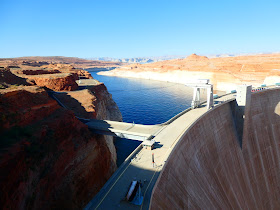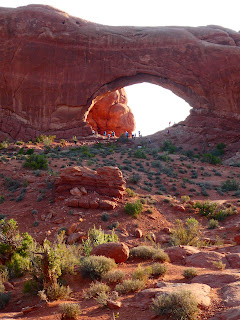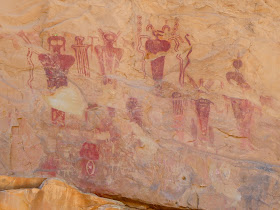This was our longest travel day of the trip. We drove from Moab, down through Blanding with a visit to the Edge of the Cedars Museum, through Monument Valley and on to Page and Lake Powell.
The Edge of the Cedars Museum has a very fine exhibit of Ancestral Puebloan artifacts in addition to a reconstructed pueblo behind the museum.
There was a
woman showing her pet educational turkey outside the front of the building. Anyone could pet him. He was very tame!
Our next stop was off of the main road to the Goosenecks State Park. This is a very small park with areas for camping, hiking along the rim, and an overlook area to view the meanderings of the San Juan River.
On to the fabulous Monument Valley. The photo at the top is the much photographed eastern approach to this area. The state line between Arizona and Utah goes right through Monument Valley, and the bulk of monument is located on the Navajo Reservation in Arizona.
We had lunch at Goulding’s Lodge.
From the Gouldings web site: “Goulding’s Lodge has been synonymous with Monument Valley for nearly a century. Harry and Leone (aka “Mike”) Goulding purchased land and started Goulding’s Trading Post in the 1920s. During the Great Depression, they saw an opportunity to bolster the local Navajo economy by bringing in movie production companies looking to film in the Southwest. Harry met with director John Ford, the wheels were immediately set in motion, and the film Stagecoach started production in Monument Valley soon after.”“Since then, Goulding’s has hosted films crews, photographers, artists and tourists from around the world. The trading post has expanded to include a lodge, campsite, tour operation, restaurant, convenience store, and a private airstrip. The LaFont family bought Goulding’s Lodge in 1981 and continues to keep the amenities modern while honoring the rich American and Navajo history surrounded by iconic landmarks.”
John Wayne
starred in “Stagecoach” and here is his cabin.
After lunch, we drove across the highway to the tribal park and visitor center. Here are some photos of the views from that location.
Before checking into our resort on the shore of Lake Powell in Page, Arizona, we stopped at the Glen Canyon Dam to have a look. Note the very low level of Lake Powell as evidenced by the broad white area around the shore.
A bit of the lake from our hotel. Time to relax after a long days drive.

























































